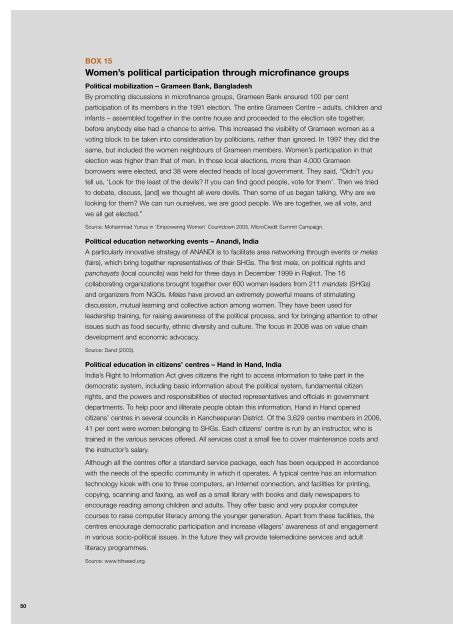Gender and rural microfinance: Reaching and empowering ... - IFAD
Gender and rural microfinance: Reaching and empowering ... - IFAD
Gender and rural microfinance: Reaching and empowering ... - IFAD
You also want an ePaper? Increase the reach of your titles
YUMPU automatically turns print PDFs into web optimized ePapers that Google loves.
BOX 15<br />
Women’s political participation through <strong>microfinance</strong> groups<br />
Political mobilization – Grameen Bank, Bangladesh<br />
By promoting discussions in <strong>microfinance</strong> groups, Grameen Bank ensured 100 per cent<br />
participation of its members in the 1991 election. The entire Grameen Centre – adults, children <strong>and</strong><br />
infants – assembled together in the centre house <strong>and</strong> proceeded to the election site together,<br />
before anybody else had a chance to arrive. This increased the visibility of Grameen women as a<br />
voting block to be taken into consideration by politicians, rather than ignored. In 1997 they did the<br />
same, but included the women neighbours of Grameen members. Women’s participation in that<br />
election was higher than that of men. In those local elections, more than 4,000 Grameen<br />
borrowers were elected, <strong>and</strong> 38 were elected heads of local government. They said, “Didn’t you<br />
tell us, ‘Look for the least of the devils? If you can find good people, vote for them’. Then we tried<br />
to debate, discuss, [<strong>and</strong>] we thought all were devils. Then some of us began talking. Why are we<br />
looking for them? We can run ourselves, we are good people. We are together, we all vote, <strong>and</strong><br />
we all get elected.”<br />
Source: Mohammad Yunus in ‘Empowering Women’ Countdown 2005, MicroCredit Summit Campaign.<br />
Political education networking events – An<strong>and</strong>i, India<br />
A particularly innovative strategy of ANANDI is to facilitate area networking through events or melas<br />
(fairs), which bring together representatives of their SHGs. The first mela, on political rights <strong>and</strong><br />
panchayats (local councils) was held for three days in December 1999 in Rajkot. The 16<br />
collaborating organizations brought together over 600 women leaders from 211 m<strong>and</strong>als (SHGs)<br />
<strong>and</strong> organizers from NGOs. Melas have proved an extremely powerful means of stimulating<br />
discussion, mutual learning <strong>and</strong> collective action among women. They have been used for<br />
leadership training, for raising awareness of the political process, <strong>and</strong> for bringing attention to other<br />
issues such as food security, ethnic diversity <strong>and</strong> culture. The focus in 2008 was on value chain<br />
development <strong>and</strong> economic advocacy.<br />
Source: D<strong>and</strong> (2003).<br />
Political education in citizens’ centres – H<strong>and</strong> in H<strong>and</strong>, India<br />
India’s Right to Information Act gives citizens the right to access information to take part in the<br />
democratic system, including basic information about the political system, fundamental citizen<br />
rights, <strong>and</strong> the powers <strong>and</strong> responsibilities of elected representatives <strong>and</strong> officials in government<br />
departments. To help poor <strong>and</strong> illiterate people obtain this information, H<strong>and</strong> in H<strong>and</strong> opened<br />
citizens’ centres in several councils in Kancheepuran District. Of the 3,629 centre members in 2006,<br />
41 per cent were women belonging to SHGs. Each citizens’ centre is run by an instructor, who is<br />
trained in the various services offered. All services cost a small fee to cover maintenance costs <strong>and</strong><br />
the instructor’s salary.<br />
Although all the centres offer a st<strong>and</strong>ard service package, each has been equipped in accordance<br />
with the needs of the specific community in which it operates. A typical centre has an information<br />
technology kiosk with one to three computers, an Internet connection, <strong>and</strong> facilities for printing,<br />
copying, scanning <strong>and</strong> faxing, as well as a small library with books <strong>and</strong> daily newspapers to<br />
encourage reading among children <strong>and</strong> adults. They offer basic <strong>and</strong> very popular computer<br />
courses to raise computer literacy among the younger generation. Apart from these facilities, the<br />
centres encourage democratic participation <strong>and</strong> increase villagers’ awareness of <strong>and</strong> engagement<br />
in various socio-political issues. In the future they will provide telemedicine services <strong>and</strong> adult<br />
literacy programmes.<br />
Source: www.hihseed.org.<br />
50

















